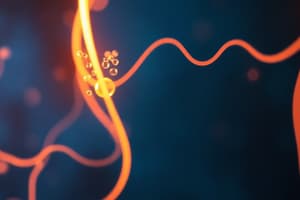Podcast
Questions and Answers
What are the two main types of metabolic processes?
What are the two main types of metabolic processes?
Catabolism and anabolism
How do photosynthetic organisms convert sunlight into chemical energy?
How do photosynthetic organisms convert sunlight into chemical energy?
By storing it in glucose
Name the process by which organisms acquire nutrients from their environment.
Name the process by which organisms acquire nutrients from their environment.
Nutrient acquisition
What is the main result of growth in organisms?
What is the main result of growth in organisms?
How do plants absorb water and minerals?
How do plants absorb water and minerals?
What leads to changes in form and function in organisms?
What leads to changes in form and function in organisms?
Describe the role of adaptations in organisms.
Describe the role of adaptations in organisms.
What is the purpose of reproduction in organisms?
What is the purpose of reproduction in organisms?
Explain the process of natural selection and its impact on populations.
Explain the process of natural selection and its impact on populations.
How do most organisms reproduce and what is the advantage of this method?
How do most organisms reproduce and what is the advantage of this method?
What are some of the complex stages that multicellular species undergo during development?
What are some of the complex stages that multicellular species undergo during development?
How do adaptations contribute to the diversity of living beings on Earth?
How do adaptations contribute to the diversity of living beings on Earth?
Flashcards are hidden until you start studying
Study Notes
Understanding Life's Essential Processes
Life is a wondrous phenomenon, characterized by myriad interactions at all levels of living organisms. At its core, life consists of interconnected processes—dynamic activities that maintain order within cells and ensure survival, growth, adaptation, and reproduction. In this exploration, we will delve into some fundamental life processes that define what it means to live.
Metabolism
Metabolic processes sustain life through energy generation, utilization, storage, and recycling of molecules. This includes catabolism (breakdown) and anabolism (synthesis), each essential for maintaining cellular homeostasis. Photosynthetic organisms convert sunlight into chemical energy stored in glucose, while other organisms generate ATP through respiration, using oxygen or alternative electron donors such as hydrogen sulfide or nitrate.
Nutrient Acquisition
Organisms obtain nutrients from their environment to build structural components like proteins, nucleic acids, lipids, carbohydrates, and vitamins. They acquire these resources via passive diffusion, active transport, or symbiotic relationships with other organisms. For example, plants absorb water and minerals through their roots, while animals ingest food and break it down through digestion.
Growth & Development
Growth results from increased size due to protein synthesis, while development leads to changes in form and function. Organisms grow through cell division and the addition of new material until they reach maturity. Many multicellular species also undergo complex stages during development, including embryogenesis, metamorphosis, and senescence.
Reproduction
The spread of genetic information over generations ensures continuity among species. Most organisms reproduce sexually, combining DNA from two parents, creating genetically diverse offspring better equipped to adapt to environmental pressures. However, certain prokaryotes reproduce asexually, cloning themselves without exchanging genes.
Adaptation & Evolution
Adaptations allow organisms to thrive in specific environments, improving their chances of survival and reproduction. These traits can evolve gradually over time through natural selection, which favors individuals best suited to their surroundings. As a result, populations change through generations, giving rise to new species.
In summary, life processes involve intricate networks of molecular events at various levels of organization. Biologists study these dynamic systems to understand how individual cells interact with one another, drive evolution, and give rise to the diversity of living beings on Earth. By examining life processes, we enhance our appreciation for the complexities inherent in life itself.
Studying That Suits You
Use AI to generate personalized quizzes and flashcards to suit your learning preferences.




